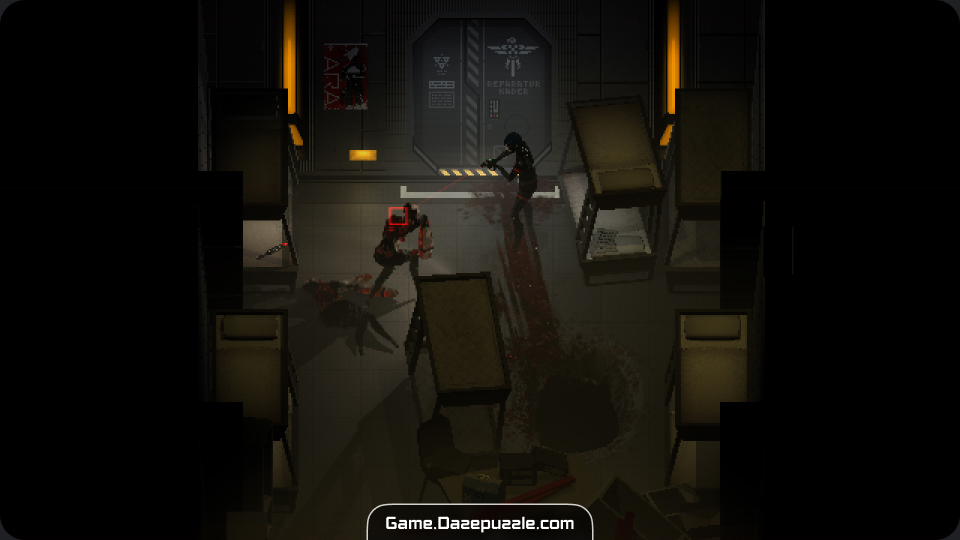In the distant reaches of a dystopian future, you awaken as Elster, a Replika searching for answers in a derelict facility buried beneath a frozen planet. Signalis drops you into a haunting survival horror experience, blending retro aesthetics with psychological dread. The story unfolds through cryptic notes, eerie environments, and a creeping sense of despair as you unravel the mystery of your missing partner, Ariane. This isn’t just a game, it’s a descent into a nightmare where every choice matters, and survival demands wits, patience, and courage.
Table of Contents
Whether you’re a first-time player or a seasoned survivor, this Signalis Game guide will walk you through everything you need to conquer Signalis with confidence. Let’s dive into the cosmic abyss together!
Getting Started: Understanding the Basics
Signalis is a love letter to classic survival horror games like Resident Evil and Silent Hill, with a top-down perspective, limited inventory, and a constant sense of danger. You’ll explore a sprawling facility filled with grotesque enemies, cryptic puzzles, and scarce resources. The game’s retro pixel art and atmospheric sound design create an oppressive mood, while its mechanics reward careful planning over reckless action. Your inventory is limited to six slots, forcing tough choices about what to carry. Ammo, healing items, and tools are finite, so resource management is key. The game also features multiple endings, encouraging replayability to uncover its full story.

Before you start, familiarize yourself with the controls. Movement is deliberate, and aiming requires precision. You’ll use a combination of weapons, tools, and environmental awareness to survive. The game autosaves at certain checkpoints, but manual saves at save rooms are crucial to avoid losing progress. With these basics in mind, let’s explore how to thrive in this unforgiving world.
Inventory Management: Travel Light, Survive Right
One of the first lessons Signalis teaches is the art of minimalism. With only six inventory slots, every item you carry is a commitment. A common mistake is hoarding weapons or supplies “just in case,” only to find yourself backtracking to storage boxes constantly. Instead, adopt a lean approach. Carry one weapon at a time, preferably a handgun for its versatility, and leave room for essential tools like keys or puzzle items. Most enemies can be avoided by running past them, so don’t feel pressured to fight every creature you encounter.
When deciding what to carry, prioritize based on your immediate needs. Heading into a puzzle-heavy area? Bring tools and keys. Expecting combat? Pack a weapon and a single stack of ammo. Healing items are tempting, but don’t carry more than one unless you’re about to face a tough section. Storage boxes are scattered throughout the facility, so use them to stash extra supplies. This approach keeps you nimble and reduces the frustration of juggling a full inventory.
Combat Strategies: Fight Smart, Not Hard
Combat in Signalis is tense and resource-intensive, so every shot counts. Enemies are resilient, often requiring multiple hits to go down, and ammo is scarce. The golden rule is to avoid fights whenever possible. Most enemies move slowly, allowing you to slip past them with careful timing. If combat is unavoidable, use these strategies to maximize efficiency.
When aiming, hold your stance until the crosshair narrows to its smallest size. This increases your damage output, often dropping enemies in half the shots. It’s tempting to fire immediately, but patience pays off. For example, a well-aimed handgun shot can down a basic enemy in two hits instead of four, saving precious ammo. If you’re facing multiple enemies, consider using the stun rod. This melee weapon can zap several foes at once, making it ideal for tight corridors or crowded rooms. It’s not a one-hit kill, but it buys you time to escape or finish them off with a follow-up attack.
Another key tactic is knowing when to burn enemy corpses. Downed enemies don’t stay dead unless you use a flare to incinerate them. Flares are rare, so reserve them for high-traffic areas where you’ll pass through repeatedly. For instance, if an enemy guards a critical hallway, burning its corpse prevents it from reviving and becoming a recurring threat. To burn a body, equip a flare, stand over the downed enemy, and use the tool action. Choose your targets wisely, flares are a finite resource, and wasting them on low-priority enemies can leave you vulnerable later.
Exploration: Leave No Stone Unturned
Exploration is the heart of Signalis. The facility is a labyrinth of locked doors, hidden items, and obscure clues. Every room holds potential rewards, but danger often lurks nearby. A common pitfall is rushing through areas with enemies, which can cause you to miss critical items like ammo, healing supplies, or puzzle components. To avoid this, adopt a thorough approach from the start.
When you enter a new room, take your time to check every corner, even if enemies are present. Interact with objects like desks, cabinets, and computers, many contain notes or items that advance the story or unlock new areas. If a room feels too dangerous, clear out enemies first or lure them away before searching. It’s easy to think you’ll “come back later” to a skipped room, but the game’s complex layout and mental demands make it hard to remember specific locations. Missing a key item can force you to backtrack through the entire facility, which is both time-consuming and stressful.
Puzzles are another core part of exploration. They range from decoding ciphers to manipulating machinery, often requiring you to combine items or interpret cryptic notes. Pay close attention to environmental clues, such as posters or diagrams, as they often hint at solutions. If a puzzle stumps you, don’t hesitate to revisit earlier areas, sometimes the answer lies in a room you’ve already passed through. Keep a mental note of locked doors or inaccessible areas, as they often become relevant later.

Resource Management: Use It or Lose It
Signalis is generous with resources, but only if you use them strategically. Hoarding ammo, healing items, or flares out of fear can make the game harder than it needs to be. If you’re low on health, use a repair patch or spray to heal up, there’s no point saving it for a “worse” moment that might never come. Similarly, don’t shy away from burning enemies in high-traffic areas or using ammo to clear a tough room. The game provides enough pickups to get through, provided you’re not wasteful.
A good rule of thumb is to assess your situation before deciding to conserve or spend. If you’re about to enter a new area with unknown threats, it’s okay to hold onto resources. But if you’re struggling in a current section, use what you have to make progress. For example, healing before a tough fight can prevent a game-over screen, and burning a key enemy can save you from repeated ambushes. Trust that the game will provide more supplies as you advance, and focus on surviving the moment.
You might also like this: Top 10 Video Game that were ahead of their time
Saving Your Progress: Stay Safe, Save Often
The save system in Signalis is a lifeline in its punishing world. Save rooms, marked by a glowing terminal, allow you to record your progress and catch your breath. While the game autosaves at certain points, relying solely on autosaves is risky. A single mistake, like running out of ammo in a tough fight or missing a critical item, can set you back significantly. To avoid this, make a habit of saving whenever you reach a save room, even if it feels unnecessary.
Saving frequently reduces stress and keeps the game’s momentum going. It’s tempting to push forward to “see what happens,” but Signalis is unpredictable, and setbacks can be brutal. For example, dying in a new area without saving might force you to replay a lengthy section, which is frustrating in a game this intense. Treat save rooms as checkpoints to regroup, reassess your inventory, and plan your next move. They’re also a rare moment of safety in an otherwise hostile world, so take advantage of them.
Puzzles and Story: Unraveling the Mystery
The puzzles in Signalis are as much a part of the experience as combat and exploration. They’re designed to challenge your problem-solving skills while deepening the game’s narrative. Some puzzles are straightforward, like finding a keycard to unlock a door, while others require lateral thinking, such as aligning radio frequencies or interpreting abstract symbols. The key to solving puzzles is patience and observation. Notes scattered throughout the facility often contain hints, so read them carefully. If a puzzle feels overwhelming, step back and explore other areas, sometimes the solution becomes clear with fresh perspective.
The story itself is a puzzle, told through fragmented notes, eerie cutscenes, and environmental storytelling. Without spoiling too much, the narrative revolves around Elster’s search for Ariane and the unsettling truths buried in the facility. Pay attention to details like radio broadcasts or graffiti, as they add context to the game’s world and its themes of memory, identity, and loss. The multiple endings depend on your actions, so experiment with different choices on replay to uncover the full scope of the story.
Advanced Tips: Mastering the Nightmare
Once you’ve got the basics down, it’s time to elevate your game. Here are some advanced strategies to make you a Signalis pro. First, learn enemy patterns. Each enemy type has distinct behaviors, some charge aggressively, while others patrol slowly. Use this to your advantage by baiting enemies into open spaces where you can dodge them easily. Second, optimize your inventory for specific tasks. If you’re solving a puzzle, swap out weapons for tools to free up slots. Third, experiment with the stun rod in creative ways, like stunning enemies to set up a quick escape or chaining stuns in a crowd.
Another pro tip is to memorize key locations, like save rooms or storage boxes, to streamline your navigation. The facility’s layout can feel overwhelming, but it becomes more manageable as you learn its structure. Finally, don’t be afraid to replay sections to perfect your approach. Signalis rewards mastery, and each run teaches you something new about its world and mechanics.

Endgame and Replayability: What Lies Beyond
As you approach the end of Signalis, the stakes rise, and the game’s mysteries deepen. Without giving anything away, expect tougher enemies, trickier puzzles, and emotional story beats. Your choices throughout the game, such as how often you fight or which items you prioritize, can influence the ending you receive. There are multiple endings, each offering a different perspective on the story, so don’t be surprised if you’re itching to replay immediately.
Replayability is a big part of Signalis’s appeal. On subsequent playthroughs, try different strategies, like relying more on melee or conserving flares for specific areas. You’ll also notice details you missed the first time, from hidden lore to subtle foreshadowing. If you’re aiming for a specific ending, experiment with your playstyle, some endings reward aggression, while others favor stealth or exploration.
Final Thoughts: Embrace the Horror
Signalis is a masterpiece of survival horror, blending retro gameplay with a haunting narrative. It’s a game that challenges you to think, plan, and persevere through its oppressive world. By traveling light, fighting smart, exploring thoroughly, and saving often, you’ll not only survive but thrive in this cosmic nightmare. The journey is tough, but the rewards, both in gameplay and story, are worth every tense moment.
So, grab your handgun, keep a flare handy, and step into the unknown. Elster’s story is waiting, and the answers are buried somewhere in the dark. What’s your favorite Signalis moment? Let us know in the comments, and happy surviving!
Thanks for keeping up with Game.Dazepuzzle.com






